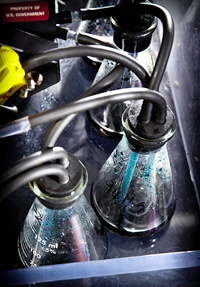New flow battery to keep big cities lit, green & safe
07 Mar 2015
Pacific Nothwest National Laboratories' (PNNL) has designed a new zinc-polyiodide flow battery, which has a high energy density, which reduces its size and cost and makes it well suited to store energy in densely populated cities. Shown here are electrolytes from another PNNL flow battery, a vanadium-redox flow battery.
 | |
| PNNL's new zinc-polyiodide flow battery has a high energy density, which reduces its size and cost and makes it well suited to store energy in densely populated cities. Shown here are electrolytes from another PNNL flow battery, a vanadium-redox flow battery |
Ensuring the power grid keeps the lights on in large cities could be easier with a new battery design that packs far more energy than any other battery of its kind and size.
The new zinc-polyiodide redox flow battery, described in Nature Communications, uses an electrolyte that has more than twice the energy density of the next-best flow battery used to store renewable energy and support the power grid. And its energy density is approaching that of a type of lithium-ion battery used to power portable electronic devices and some small electric vehicles.
"With improved energy density and inherent fire safety, flow batteries could provide long-duration energy storage for the tight confines of urban settings, where space is at a premium," said Imre Gyuk, energy storage program manager at the Department of Energy's Office of Electricity Delivery and Energy Reliability, which funded this research. "This would enhance the resiliency and flexibility of the local electrical grid."
"Another, unexpected bonus of this electrolyte's high energy density is it could potentially expand the use of flow batteries into mobile applications such as powering trains and cars," said the study's corresponding author, Wei Wang, a materials scientist at DOE's Pacific Northwest National Laboratory.
Going with the flow
Both flow and lithium-ion batteries were invented in the 1970s, but only the lithium-ion variety took off at that time. Lithium-ion batteries could carry much more energy in a smaller space than flow batteries, making them more versatile. As a result, lithium-ion batteries have been used to power portable electronics for many years. And utilities have begun using them to store the increasing amounts of renewable energy generated at wind farms and solar power facilities.
But the high-energy lithium-ion batteries' packaging can make them prone to overheating and catching fire.
Flow batteries, on the other hand, store their active chemicals separately until power is needed, greatly reducing safety concerns. This feature has prompted researchers and developers to take a serious second look at flow batteries.






























